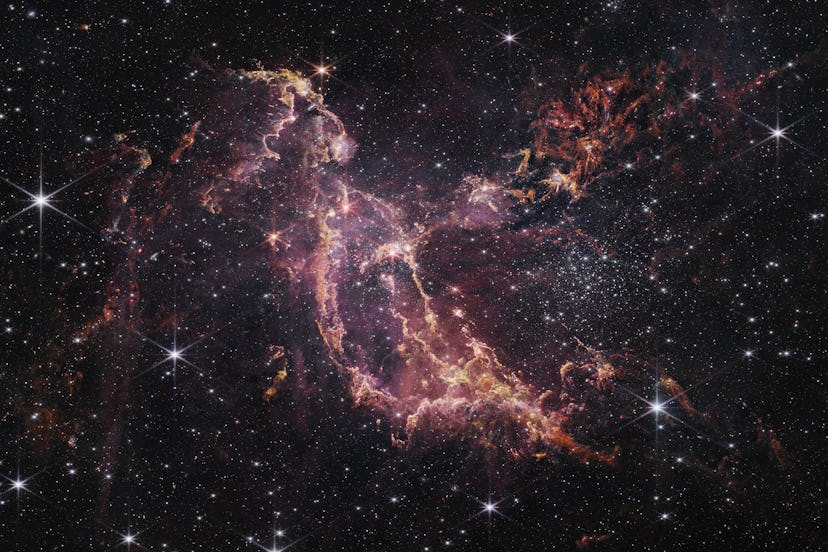This JWST Photo Of The Star-Forming Region NGC 346 Is Astoundingly Beautiful
NASA has released another image taken from the James Webb Space Telescope (JWST), and of course, it’s another magical beauty.

NASA has released another image taken from the James Webb Space Telescope (JWST); of course, it’s another magical beauty. The latest image explores “one of the most dynamic star-forming regions in nearby galaxies,” and the observations made by the telescope are another advancement for astronomers — and another incredible image for us to gaze at.
The JWST recently captured a look at NGC 346, the only young star cluster located in a dwarf galaxy close to our Milky Way that’s called the Small Magellanic Cloud (SMC), according to the NASA release. Some new discoveries came as a result, specifically about the metals floating in space.
“Since dust grains in space are composed mostly of metals, scientists expected there would be low amounts of dust and that it would be hard to detect,” NASA states. “New data from Webb reveals the opposite.”
Can you explain what this new photo means like I’m five?
Absolutely! In this photo, we’re looking at a dwarf galaxy, and this particular area is called the NGC 346. The reason astronomers are interested in this area is because of the conditions and metals within the Small Magellanic Cloud.
“Astronomers probed this region because the conditions and amount of metals within the SMC resemble those seen in galaxies billions of years ago, during an era in the universe known as ‘cosmic noon,’ when star formation was at its peak,” per NASA. Those early events are still shaping galaxies all around us, even today.
“A galaxy during cosmic noon wouldn’t have one NGC 346 like the Small Magellanic Cloud does; it would have thousands,” of star-forming regions like this one, said Margaret Meixner, an astronomer at the Universities Space Research Association and principal investigator of the research team.
“But even if NGC 346 is now the one and only massive cluster furiously forming stars in its galaxy, it offers us a great opportunity to probe conditions in place at cosmic noon.”
NGC 346 is about 200,000 light years away. The JWST discovered that within it are more “building blocks” for planets and stars than scientists had previously expected.
The clouds are full of hydrogen and dust, and the colors all represent something different. The pink colors are “energized hydrogen,” and the orange is “dense, molecular hydrogen.”
“Since the Small Magellanic Cloud has a similar environment to galaxies during cosmic noon, it’s possible that rocky planets could have formed earlier in the universe than we might have thought,” Guido De Marchi of the European Space Agency, a co-investigator on the research team said, per the NASA release.
To read more about this amazing photo and the potential the discovery has to advance astronomy, visit NASA.
This article was originally published on